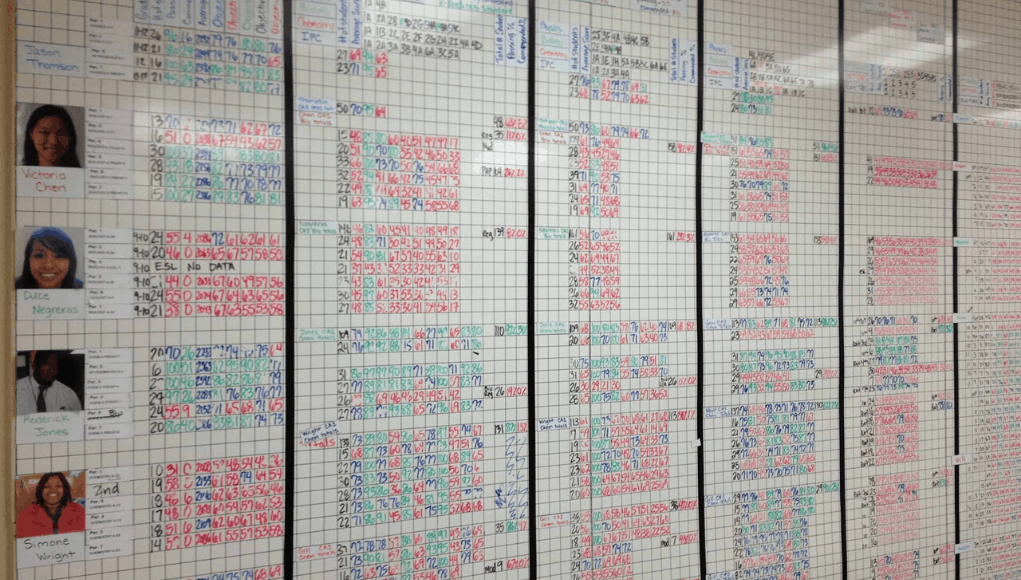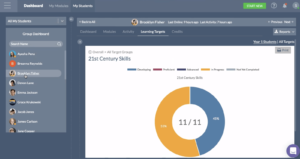Competency Tracking Tools Are Overdue

Despite billions of dollars flowing into the edtech space, we’re stuck with learning platforms suited for 1980s schools—and the 1890s courses and grading system they’re based on.
Matthew Pittinsky and some colleagues started Blackboard in 1997 and kicked off the modern age of learning management systems (LMS). It was a big deal at the time and helped usher in the shift from print to digital. But LMS have not changed much—they all presume a sequence of disconnected, disciple-based courses for which students receive letter grades (often an averaged mess of achievement, efforts, and attendance). It’s a lousy way to organize and report on modern learning.
Why so little progress in two decades? Well-intentioned federal policy passed in 2001 reinforced a focus on grade-level proficiency. Higher education continues to value traditional transcripts, grades and standardized tests. Both factors have locked-in traditional structures and communication vehicles.
On the edtech front, Google and then Microsoft offered free learning platforms, which resulted in dampened LMS investment. Gradebooks are often associated with student information systems (SIS), which also produce compliance reports for districts and states—making relationships sticky and innovation low.
While there are many reasons for market blockages, the demand for competency tracking is exploding. The shift to 1:1 computer access in most schools has resulted in a dramatic increase in the amount formative feedback from assessments embedded in digital curriculum and available from a variety of educational applications. The result is an order of magnitude increase in formative feedback in traditional academic competencies. (Combining those can be a challenge, but that’s a different blog on interoperability).
The result of more feedback without systems to capture the data is hand-scribbled data walls (like the featured image) and lots of spreadsheets.
Beyond reading, writing, and math, thousands of schools have or are in the process of adopting a portrait of a graduate that incorporates the aspirations of a community, often including communication, collaboration, critical thinking, and other workplace success skills. States including South Carolina, Virginia, and Vermont have adopted broader measures of success.
ACT, known for its college entrance exam, introduced a Holistic Framework that includes cross-cutting capabilities such as critical thinking, collaborative problem solving, and information and technology skills as well as behavioral skills. Similarly, KnowledgeWorks’ Foundation of Readiness puts social and emotional learning at the heart of an outcome framework focused on the future of work.
Grant-funded school networks often adopt broader measures of success. Four years ago, XQ Institute began making grants to innovative high schools that adopted the XQ Learner Goals, a composite framework that includes “Original Thinkers” and “Generous Collaborators” and adds “Learning for Life”.
The Mastery Transcript Consortium is helping more than 300 schools create a high school transcript that reflects the unique skills, strengths, and interests of each learner. This new format will encourage higher education to accept alternative formats and will influence high school transformation as well.
Last week, I visited three innovative schools struggling with competency tracking. A Memphis school uses Powerschool to report attendance and grades to the authorizer, but tracks progress on 12 competencies manually. An Oakland school tracks progress on nine cross-cutting competencies by hand. A Kansas City school teaches leadership and design thinking without a great system for tracking growth in these foundational skills.
The Path Forward
The exploding demand for competency tracking deserves better tools than the venture-backed edtech market has provided. The path forward is likely to require funding by impact investors that see the growing demand to support emerging solutions.
Design principles for new systems will include:
- Flexible configuration: easy to set up school-specific competencies.
- Planning capabilities: authoring tools that make it easy to bring competencies into less/unit design.
- Multiple inputs: flexibility to capture multiple forms of feedback including teacher observations, surveys, and assessments.
- Combining features: the potential to give preference to recent feedback and certain sources.
- Evidence components: including or linking to a portfolio of artifacts.
- Petition processes: a way for learners to submit evidence of competencies demonstrated outside of school.
- Asynchronous communication: support for regular parent and stakeholder feedback (i.e., new report cards) and extended transcripts.
LMS and SIS are foundational to a school’s tech stack, but developers are playing from behind and serving a timid audience when it comes to switching enterprise systems. In a recent exchange, a learning platform CEO admitted, “We make platforms for the schools we have.” What he’s missing is that the demand for better tools to track competencies grows every week.
Many teachers have flocked to ‘free for teacher’ standalone gradebooks, but when the bell rings students go to the next class and are assessed traditionally with letter grade—and the teacher has to double enter grades into the official system.
The fact that tens of thousands of schools continue to manually track student growth on important competencies via spreadsheets (or hand-scribbled data walls) is crazy.
Promising solutions are most likely to emerge from partnerships between networks of schools that share thoughtful outcome frameworks and learning models, scaled providers, and impact investors. It’s time for modern solutions for schools trying to develop the 2030 workforce.
For more, see:
- 33 Quality Learning Platforms (2018 list)
- Getting Smart on Next-Gen Learning Platforms (2015 review)
- The Promise & Challenge of Student-Centered Learning
- Teachers Deserve Better Tools for Tracking Subskills (2014)
Stay in-the-know with innovations in learning by signing up for the weekly Smart Update.
This post was originally published on Forbes.







Joost Allard
An EdTech solution that already incorporates these design principles is Foundry from Project Foundry, available in both a single teacher version (Foundry Forge) and all-school version (Foundry Transform). A roadmap exists that incorporates extending data exchange with other systems such as the Mastery Transcript Consortium as well as with existing SIS systems.